肯定句变成否定句
- 格式:pptx
- 大小:124.64 KB
- 文档页数:9
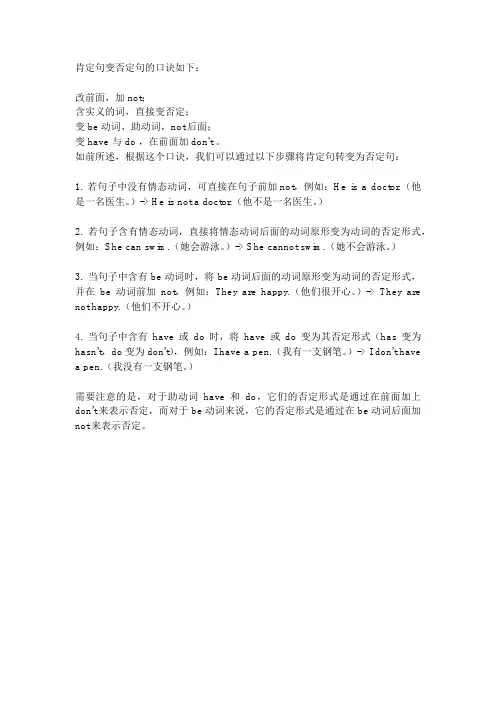
肯定句变否定句的口诀如下:
改前面,加not;
含实义的词,直接变否定;
变be动词、助动词,not后面;
变have 与 do ,在前面加don't 。
如前所述,根据这个口诀,我们可以通过以下步骤将肯定句转变为否定句:
1. 若句子中没有情态动词,可直接在句子前加not,例如:He is a doctor.(他是一名医生。
)-> He is not a doctor.(他不是一名医生。
)
2. 若句子含有情态动词,直接将情态动词后面的动词原形变为动词的否定形式,例如:She can swim.(她会游泳。
)-> She cannot swim.(她不会游泳。
)
3. 当句子中含有be动词时,将be动词后面的动词原形变为动词的否定形式,并在be动词前加not,例如:They are happy.(他们很开心。
)-> They are not happy.(他们不开心。
)
4. 当句子中含有have或do时,将have或do变为其否定形式(has变为hasn't,do变为don't),例如:I have a pen.(我有一支钢笔。
)-> I don't have a pen.(我没有一支钢笔。
)
需要注意的是,对于助动词have和do,它们的否定形式是通过在前面加上don't来表示否定,而对于be动词来说,它的否定形式是通过在be动词后面加not来表示否定。
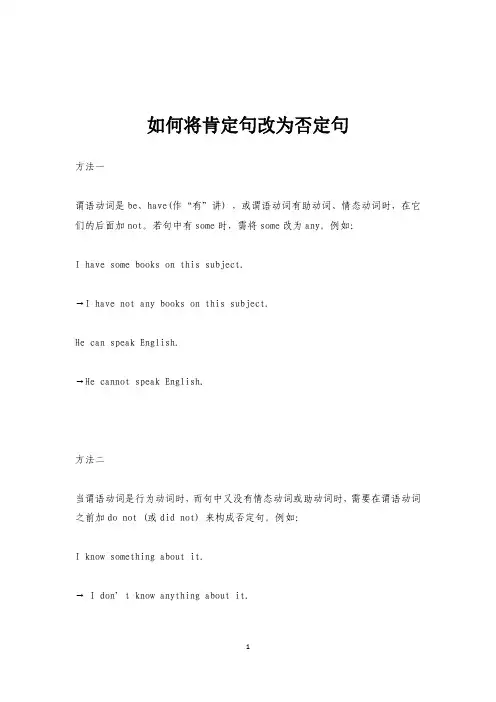
如何将肯定句改为否定句方法一谓语动词是be、have(作“有”讲) ,或谓语动词有助动词、情态动词时,在它们的后面加not。
若句中有some时,需将some改为any。
例如:I have some books on this subject.→I have not any books on this subject.He can speak English.→He cannot speak English.方法二当谓语动词是行为动词时,而句中又没有情态动词或助动词时,需要在谓语动词之前加do not (或did not) 来构成否定句。
例如:I know something about it.→ I don’t know anything about it.方法三否定由think、believe、know等动词引出的宾语从句时,应将主句改为否定形式。
例如:She knows why the train is late.→She doesn’t know why the train is late.方法四祈使句的否定形式是在谓语动词前直接加do not。
例如:Read in bed.→Don’t read in bed.方法五如果肯定句是特殊句型,则要具体问题具体分析:陈述句中含有had better时,变为否定句时,要把not加在better后。
例如:You had better go with me.→You had better not go with me.陈述句中含有both (all) of +名词作主语时,改为否定句时,要用neither 来代替both,none代替all。
并注意谓语动词数的变化。
例如:Both of them are Americans.→Neither of them is American.。

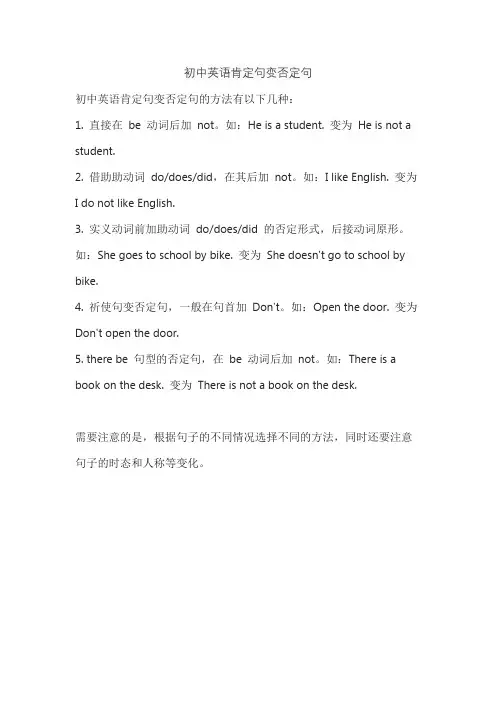
初中英语肯定句变否定句
初中英语肯定句变否定句的方法有以下几种:
1. 直接在be 动词后加not。
如:He is a student. 变为He is not a student.
2. 借助助动词do/does/did,在其后加not。
如:I like English. 变为
I do not like English.
3. 实义动词前加助动词do/does/did 的否定形式,后接动词原形。
如:She goes to school by bike. 变为She doesn't go to school by bike.
4. 祈使句变否定句,一般在句首加Don't。
如:Open the door. 变为Don't open the door.
5. there be 句型的否定句,在be 动词后加not。
如:There is a book on the desk. 变为There is not a book on the desk.
需要注意的是,根据句子的不同情况选择不同的方法,同时还要注意句子的时态和人称等变化。

肯定句变否定句的基本方法一、动词be 的否定式动词be根据不同的人称和时态可以有am, is, are, was, were等不同形式,可用作连系动词(表示“是”、“在”等)和助动词(用于构成进行时态和被动语态等),但不管何种情况,构成否定式时,一律在其后加notI’m old, but you’re young. 我老了,但你还年轻。
→I’m not old, but you’re not young. 我还不老,但你不年轻了。
He was reading and I was writing. 他在读,我在写。
→He was not reading and I was not writing. 他没有在读,我没有在写。
二、动词have 的否定式动词have根据不同的人称和时态可以有have, has, had等形式,可以用作实意动词和助动词,分以下情况讨论1. 用作实意动词表示状态,如表示拥有、患病或用于have to表示“必须”等,在构成否定式时可以直接在其后加not,也可根据情况在其前使用don’t, doesn’t, didn’tHe has a car. 他有辆小汽车。
→He hasn’t a car. / He doesn’t have a car. 他没有小汽车。
He had some dictionaries. 他有一些词典。
→He hadn’t any dictionaries. / He didn’t have any dictionaries. 他没有词典。
You have to go with him. 你必须同他一起去。
→You haven’t to go with him. / You don’t have to go w ith him. 你不必同他一起去。
【注】have to构成否定式时以在其前加don’t等较为常见。
2. 用作实意动词表示动作,如表示“吃(=eat)”、“喝(=drink)”、“拿(=take)”、“收到(=receive)”、“度过(=spend)”等,构成否定式时不能直接在其后加not,而应根据情况在其前使用don’t, doesn’t, didn’tHe had some cake for breakfast. 他早餐吃了些蛋糕。
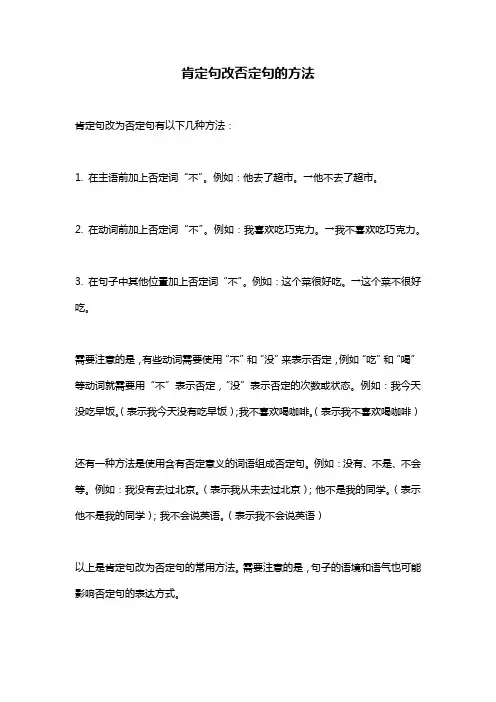
肯定句改否定句的方法
肯定句改为否定句有以下几种方法:
1. 在主语前加上否定词“不”。
例如:他去了超市。
→他不去了超市。
2. 在动词前加上否定词“不”。
例如:我喜欢吃巧克力。
→我不喜欢吃巧克力。
3. 在句子中其他位置加上否定词“不”。
例如:这个菜很好吃。
→这个菜不很好吃。
需要注意的是,有些动词需要使用“不”和“没”来表示否定,例如“吃”和“喝”等动词就需要用“不”表示否定,“没”表示否定的次数或状态。
例如:我今天没吃早饭。
(表示我今天没有吃早饭);我不喜欢喝咖啡。
(表示我不喜欢喝咖啡)
还有一种方法是使用含有否定意义的词语组成否定句。
例如:没有、不是、不会等。
例如:我没有去过北京。
(表示我从未去过北京);他不是我的同学。
(表示他不是我的同学);我不会说英语。
(表示我不会说英语)
以上是肯定句改为否定句的常用方法。
需要注意的是,句子的语境和语气也可能影响否定句的表达方式。
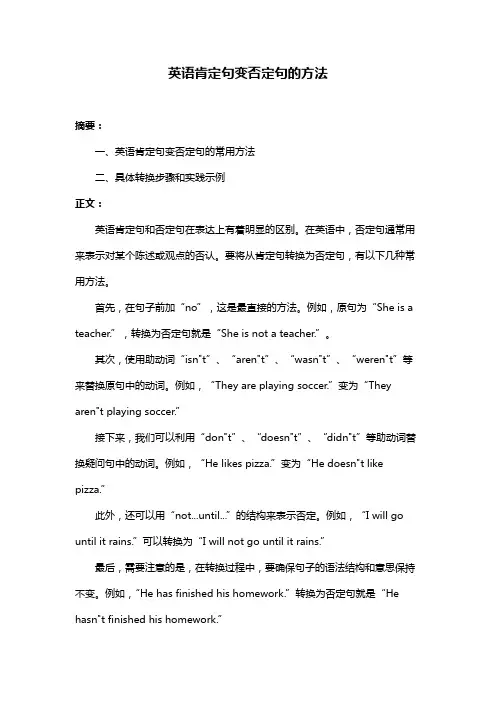
英语肯定句变否定句的方法摘要:一、英语肯定句变否定句的常用方法二、具体转换步骤和实践示例正文:英语肯定句和否定句在表达上有着明显的区别。
在英语中,否定句通常用来表示对某个陈述或观点的否认。
要将从肯定句转换为否定句,有以下几种常用方法。
首先,在句子前加“no”,这是最直接的方法。
例如,原句为“She is a teacher.”,转换为否定句就是“She is not a teacher.”。
其次,使用助动词“isn"t”、“aren"t”、“wasn"t”、“weren"t”等来替换原句中的动词。
例如,“They are playing soccer.”变为“They aren"t playing soccer.”接下来,我们可以利用“don"t”、“doesn"t”、“didn"t”等助动词替换疑问句中的动词。
例如,“He likes pizza.”变为“He doesn"t like pizza.”此外,还可以用“not...until...”的结构来表示否定。
例如,“I will go until it rains.”可以转换为“I will not go until it rains.”最后,需要注意的是,在转换过程中,要确保句子的语法结构和意思保持不变。
例如,“He has finished his homework.”转换为否定句就是“He hasn"t finished his homework.”总之,掌握以上方法,就可以轻松地将英语肯定句转换为否定句。
在实际应用中,根据不同的语境和句子结构,选择合适的方法进行转换,使句子更加丰富和生动。

一、简单句中含有be动词、情态动词和助动词时,变否定句时需在be动词、情态动词和助动词后加not。
1。
(am,is ,are 是be动词)如:I am a teacher.→I am not a teacher.This is a pen.→ This is not a pen。
或This isn’t a pen。
(is not =isn't) You are a boy. →You are not a boy。
(are not =aren't)2. (can是情态动词)He can help me.→He can not help me.或He can’t help me。
(can not =can't )3.当主语是第一人称、第二人称和第三人称复数时用助动词do,变否定时,在do后面加not 如:I like English .I do not like English。
或I don’t like English。
They go to school together。
→They do not (don’t)go to school together。
4。
当主语是第三人称单数时用does,变否定时,在does后面加not,如:The little girl wants to go there。
→ The little girl does not (doesn’t )want to go there.2.简单句中谓语动词为行为动词时,要根据时态选用do的相应形式,把肯定句变为否定句。
如:The little girl wants to go there.→The little girl doesn’t want to go there.He did his work yesterday.→He didn't do his work yesterday.3.祈使句变否定句时,一般在句首加Don’t,但Let us或Let’s 开头的祈使句在Let us或Let's后加not也可.如:Put them over there.→Don't put them over there.Let us go home.→Let us not go home.或Don’t let us go home.4.主从复合句中,主句是I think,I believe等结构,变否定句时,形式上否定主句,实际上否定从句.如:I don't think chickens can swim .我认为鸡不会游泳. 5.“had better +动词原形”,变否定句时为“had better not +动词原形”。
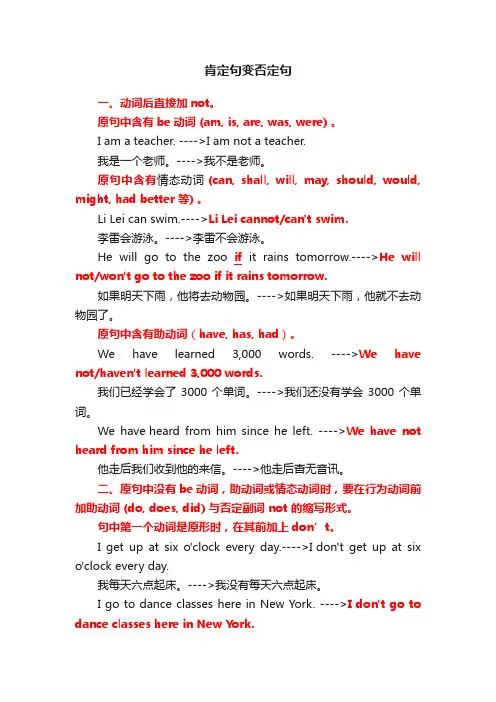
肯定句变否定句一、动词后直接加not。
原句中含有be动词 (am, is, are, was, were) 。
I am a teacher. ---->I am not a teacher.我是一个老师。
---->我不是老师。
原句中含有情态动词 (can, shall, will, may, should, would, might, had better 等) 。
Li Lei can swim.---->Li Lei cannot/can't swim.李雷会游泳。
---->李雷不会游泳。
He will go to the zoo if it rains tomorrow.---->He will not/won't go to the zoo if it rains tomorrow.如果明天下雨,他将去动物园。
---->如果明天下雨,他就不去动物园了。
原句中含有助动词(have, has, had)。
We have learned 3,000 words. ---->We have not/haven't learned 3,000 words.我们已经学会了3000个单词。
---->我们还没有学会3000个单词。
We have heard from him since he left. ---->We have not heard from him since he left.他走后我们收到他的来信。
---->他走后杳无音讯。
二、原句中没有be动词,助动词或情态动词时,要在行为动词前加助动词 (do, does, did) 与否定副词 not 的缩写形式。
句中第一个动词是原形时,在其前加上don’t。
I get up at six o'clock every day.---->I don't get up at six o'clock every day.我每天六点起床。
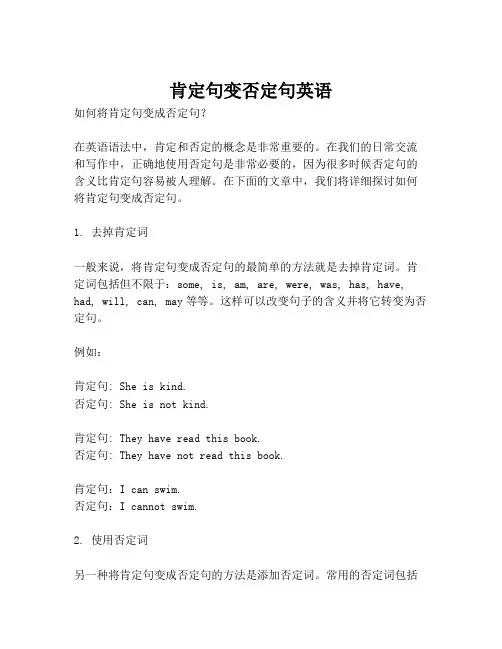
肯定句变否定句英语如何将肯定句变成否定句?在英语语法中,肯定和否定的概念是非常重要的。
在我们的日常交流和写作中,正确地使用否定句是非常必要的,因为很多时候否定句的含义比肯定句容易被人理解。
在下面的文章中,我们将详细探讨如何将肯定句变成否定句。
1. 去掉肯定词一般来说,将肯定句变成否定句的最简单的方法就是去掉肯定词。
肯定词包括但不限于:some, is, am, are, were, was, has, have, had, will, can, may等等。
这样可以改变句子的含义并将它转变为否定句。
例如:肯定句: She is kind.否定句: She is not kind.肯定句: They have read this book.否定句: They have not read this book.肯定句:I can swim.否定句:I cannot swim.2. 使用否定词另一种将肯定句变成否定句的方法是添加否定词。
常用的否定词包括但不限于:no, not, never, nothing, neither等等。
使用这些否定词能给句子带来否定的意义。
例如:肯定句: He asked me something.否定句: He didn’t ask me anything.肯定句: He always comes late.否定句: He never comes early.肯定句: I like coffee.否定句: I don’t like coffee.3. 使用相反的形容词或副词在有些情况下,我们可以使用相反的形容词或副词来将肯定句变成否定句。
例如,将“happy”换成“unhappy”,将“fast”换成“slow”等等。
例如:肯定句:She is beautiful.否定句:She is not ugly.肯定句:He is tall.否定句:He is not short.肯定句:He runs fast.否定句:He does not run slowly.总之,在英语语法中,正确使用肯定句和否定句非常重要。
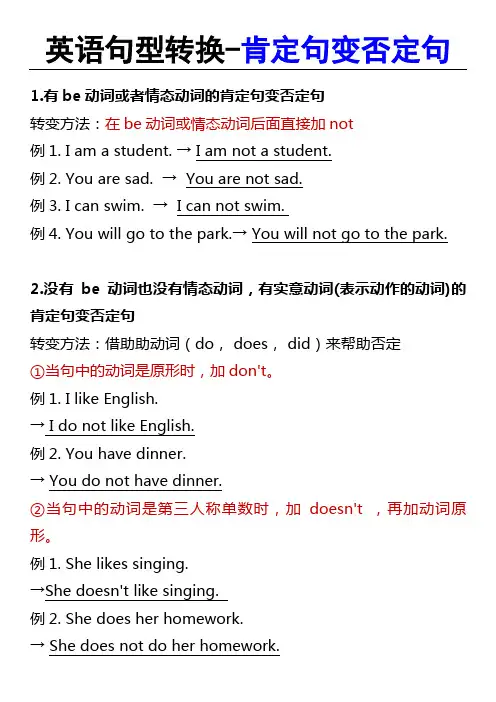
1.有be动词或者情态动词的肯定句变否定句转变方法:在be动词或情态动词后面直接加not例1. I am a student. → I am not a student.例2. You are sad. → You are not sad.例3. I can swim. → I can not swim.例4. You will go to the park.→ You will not go to the park.2.没有be动词也没有情态动词,有实意动词(表示动作的动词)的肯定句变否定句转变方法:借助助动词(do, does, did)来帮助否定①当句中的动词是原形时,加don't。
例1. I like English.→ I do not like English.例2. You have dinner.→ You do not have dinner.②当句中的动词是第三人称单数时,加doesn't ,再加动词原形。
例1. She likes singing.→She doesn't like singing.例2. She does her homework.→ She does not do her homework.③当句中的动词是过去式时,用didn't,加动词原形例: We had a great time during our holidays.→We did not have a great time during our holidays.3. 动词have/has的特殊说明:①当have表示“某人有什么的时候”,其否定形式为have not/has not例: She has two books.→ She has not two books.②当have作为实意动词时,其否定形式为do not have/does not have例: You have dinner.→You do not have dinner.③当have在完成时中作为助动词时,其否定形式为have not/has not例: I have seen this film.→ I have not seen this film.4. 一些特殊说明:①肯定陈述句中的some/too,在否定陈述句中应改为any/either。
一、肯定句改否定句的方法:1、在be动词后加not。
如:is not , are not ,am not, was not, were not;2、在can,should, will等后加not。
如:cannot,should not, will not;3、上述都没有的,在动词前加助动词否定形式don’t/doesn’t/didn’t。
4、 some 改成any。
如: I am a girl. → I am not a girl.You are a student. →You are not a student.→You aren’t a student.This is Tom’s bag, → This is not Tom’s bag.→ This isn’t Tom’s bag.答题方法是;否定词not在be后边。
二、肯定句改一般疑问句的方法:1、把be动词放在句首,剩下的照抄,(some 改成any,I改成you,my改成your,)句点改成问号。
2、把can,shall, will等放到句首,剩下的照抄,(some 改成any,I改成you,my改成your,)句点改成问号。
3、上述都没有的,在句首请助动词Do/Does/Did帮忙,剩下的照抄,(some 改成any,I改成you,my 改成your,)句点改成问号。
注意:句首的第一个字母要大写,句尾标点应为“?”。
如:I am in Class 6. →Are you in Class 6?You are from America. →Are you from America? It is an orange. →Is it an orange?答题方法是:要想提问,be提前,句末“?”别忘了。
4、就一般疑问句回答一般疑问句有两种回答,即:肯定回答和否定回答。
其中,肯定回答用yes,否定回答用no。
语句顺序为:Yes + 主语+ am /is/ are/was/were.|can.|do/does/did|; No + 主语+ am not/ isn’t/ aren’t/wasn't/weren't.|can't.|don't/doesn't/didn't |.。
英语肯定句改为否定句口诀
以下是一些常见的英语肯定句改为否定句的口诀,帮助您快速掌握。
1.一般现在时
-肯定句:主语+动词原形
-否定句:主语+do/does not+动词原形
2.一般过去时
-肯定句:主语+动词过去式
-否定句:主语+did not+动词原形
3.一般将来时
-肯定句:主语+will+动词原形
-否定句:主语+will not/won't+动词原形
4.现在进行时
-肯定句:主语+am/is/are+动词-ing形式
-否定句:主语+am/is/are not+动词-ing形式
5.现在完成时
-肯定句:主语+have/has+过去分词
-否定句:主语+have/has not+过去分词
6.过去进行时
-肯定句:主语+was/were+动词-ing形式
-否定句:主语+was/were not+动词-ing形式
7.过去完成时
-肯定句:主语+had+过去分词
-否定句:主语+had not+过去分词
8.情态动词
-肯定句:主语+情态动词+动词原形
-否定句:主语+情态动词+not+动词原形
9.be动词(一般现在时)
-肯定句:主语+am/is/are
-否定句:主语+am/is/are not
10.be动词(一般过去时)
-肯定句:主语+was/were
-否定句:主语+was/were not
这些口诀可以帮助您快速记住肯定句改为否定句的基本规则。
然而,需要注意的是,有些特殊情况下,否定形式可能会有其他变化或使用不同的词汇。
因此,在具体应用时,仍需结合具体语境和语法规则进行判断和运用。
一、简单句中含有be动词、情态动词和助动词时,变否定句时需在be动词、情态动词和助动词后加not。
1. (am, is ,are 是be动词)如:I am a teacher.→I am nota teacher.This is a pen.→ This is not a pen.或This isn’t a pen. (is not =isn’t) You are a boy. →You are not a boy. (are not =aren’t)2. (can是情态动词)He can help me.→He can not help me.或He can’t help me.(can not =can’t )3.当主语是第一人称、第二人称和第三人称复数时用助动词do,变否定时,在do后面加not 如:I like English .I do not like English.或I don’t like English.They go to school together. →They do not (don’t) go to school together.4.当主语是第三人称单数时用does,变否定时,在does后面加not,如:The little girl wants to go there.→ The little girl does not (doesn't ) want to go there.2.简单句中谓语动词为行为动词时,要根据时态选用do的相应形式,把肯定句变为否定句。
如:The little girl wants to go there.→The little girl doesn't want to go there.He did his work yesterday.→He didn't do his work yesterday.3.祈使句变否定句时,一般在句首加Don't,但Let us或Let's 开头的祈使句在Let us或Let's后加not也可。
简单肯定句变否定句
简单肯定句指的是陈述一个事实或情况的句子,而简单否定句则是指否定这个事实或情况的句子。
下面介绍一些常见的简单肯定句变否定句的方法:
1. 在动词前加上否定词not。
例如:He is happy.(他很高兴。
)→ He is not happy.(他不高兴。
)
2. 使用否定形式的动词。
例如:She doesn't like coffee.(她不喜欢咖啡。
)
3. 使用否定的副词或形容词来修饰动词或名词,例如:The weather is not good.(天气不好。
)→ He is not very tall.(他不是很高。
)
需要注意的是,一些特殊的动词和形容词在否定时会有不同的形式,例如:
1. be动词的否定形式是not be。
例如:I am not hungry.(我不饿。
)
2. have动词的否定形式是do not have或have not。
例如:She does not have a car.(她没有车。
)
3. can动词的否定形式是cannot或can't。
例如:I cannot swim.(我不会游泳。
)
4. some和any的否定形式是no和none。
例如:There is no milk in the fridge.(冰箱里没有牛奶。
)
总之,掌握简单肯定句变否定句的方法是英语学习中的基础,需
要多加练习和记忆。